Draft Rules For Dual-Use Solar Energy Pilot Program & Public Information Session
The Rutgers Agrivoltaics Program wraps up its first year of crops research in New Jersey
The Rutgers Agrivoltaics Program is a multidisciplinary group of Rutgers faculty and staff committed to designing and conducting applied agrivoltaics research and outreach for stakeholders in New Jersey and throughout the region.
The Rutgers Agrivoltaics Program (RAP) was initiated over 3 years ago with the signing and passage of the Dual Use Solar Act by the New Jersey legislature. In 2023, agrivoltaics (AV) research installations were established at three Rutgers-New Jersey Agricultural Experiment Stations (NJAES). One at the Clifford E. and Melda C. Snyder Research and Extension Farm in Pittstown, NJ; one at the Animal Farm on the Rutgers New Brunswick (SEBS) Campus, and one at the Rutgers Agricultural Research and Extension Center (RAREC) near Bridgeton, NJ. Members of the Rutgers RAP Team in collaboration the New Jersey Board of Public Utilities, NJ Department of Agriculture, and NJ-DEP are now in the process of implementing the Dual-Use Solar Energy Pilot Program.

Specialty crops being grown in a double panel AV plot at the Rutgers Agricultural Research and Extension Center near Bridgeton, New Jersey.
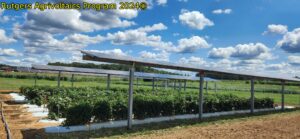
An image of specialty crops being grown in a single AV panel plot at the Rutgers Agricultural Research and Extension Center near Bridgeton, New Jersey.
The agrivoltaics research at the Rutgers Agricultural Research and Extension Center (RAREC) near Bridgeton, New Jersey was designed to study the effects of agrivoltaics systems on the production of specialty and agronomic crops. This year eggplant, bell pepper, fresh-market tomato, and soybeans were grown under three different treatments: single-axis tracking array with one row of panels, single-axis tracking array with two rows of panels, and no panels (conventional production as a control) to determine the effects of the panels on crop yield and quality.

Soybeans were grown in two whole blocks at the Rutgers Agricultural Research and Extension Center near Bridgeton, NJ in 2024.
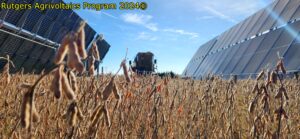
Soybeans being harvested between double AV panel arrays at the Rutgers Agricultural Research and Extension Center near Bridgton, New Jersey.
At the Clifford E. and Melda C. Snyder Research and Extension Farm in Pittstown, NJ the effects of single-axis tracking arrays with one row of panels on forage growth was studied to measure potential impacts on hay yield and quality. There were three cuts of the hay this season along with sampling for forage quality.

Hay being cut in mid-May at the Snyder Research and Extension Farm in northern New Jersey.
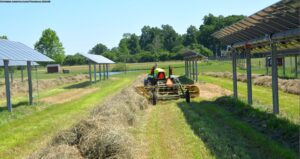
Cut hay being wind-rowed at the Snyder Research and Extension Farm in northern New Jersey.
At the Rutgers SEBS Cook Campus Animal Farm in New Brunswick, New Jersey, which hosts equine and livestock facilities, research was done to study pasture forage production and animal grazing patterns in combination with vertical bifacial solar panels. In early fall, four gestational cows (led by Buttercup) were introduced to the AV array research pasture for the first time. The research pasture also includes shelter and drinking water for the animals.
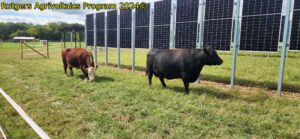
Buttercup (on the right) leading the small herd into the field of vertical bifacial panels at the Cook Campus Animal Farm on the campus of Rutgers University in New Brunswick, NJ.
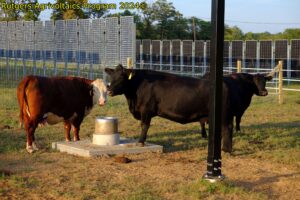
Buttercup and friends at the watering hole.

The ribbon cutting ceremony held on 30 Sep 2024 at the Cook Campus Animal Farm on the SEBS campus of Rutgers University celebrating the accomplishments Rutgers Agrivoltaics Program.
On 30 Sep., over 80 people attended the Rutgers Agrivoltaics Program ribbon cutting ceremony at the Rutgers Animal Farm in New Brunswick, NJ where State officials, University leaders, and invited guests applauded the research and outreach efforts of the Rutgers Agrivoltaics Program and discussed the potential impacts of agrivoltaics for both the agricultural and solar industries in New Jersey.
Results from all three Rutgers Agrivoltaics Program research sites will be presented at upcoming Extension meetings this winter and spring across New Jersey and the region.
UPCOMING PPRESENTATIONS
Dan Ward will be presenting at the New England Fruit and Vegetable Conference on 18 December 2024 in Manchester, New Hampshire.
Multiple RAP Team members will be presenting in the morning Agrivoltaics Session at the 2025 New Jersey Agricultural Convention and Trade Show in Atlantic City on 5 February at Harrah’s Resort.
More to be announced!
For more information on the Rutgers Agrivoltaics Program and more AV resources please visit the new RAP website by clicking here. Stakeholders interested in keeping up the what’s going on can now subscribe to the new website and have information send directly to their email account. Just go to our contact page and follow the instructions to subscribe!
Articles and images can be used by Permission from the Rutgers RAP Team only – For Permission contact RAP at shawn.sorrels@rutgers.edu.
Recommendations for Neopestalotiopsis control in fall planted strawberries
A new article by Dr. Phil Brennan (University of Georgia) from the Strawberry News website (UGA) has been published with information compiled by Dr. Guido Schnabel (Clemson University) and Dr. Bill Cline (North Carolina State) on managing fall-planted strawberries with the known presence of Neopestalotiopsis. New Jersey growers who may have purchased strawberry plants this fall from sources with known Neopestalotiopsis issues need to be proactive in mitigating it as best they can this fall and develop a plan for the upcoming spring. For more information please click here.
For more information on diagnosing Neopestalotiopsis in strawberry please click here.
Agri-Technology and Research Twilight Meeting at RAREC
Agri-Technology and Research Twilight Meeting at RAREC
Thursday September 19th, 2024
4 pm until dark
Location: Rutgers Agricultural Research and Extension Center (RAREC)
121 Northville Road
Bridgeton, New Jersey 08302
This year’s twilight meeting at RAREC will continue to showcase new agricultural technologies for stakeholders in the state. We will showcase the newly operating agrivoltaics system with specialty crops (fresh-market tomatoes, bell pepper, and eggplant) and soybeans growing beneath them and discuss new technologies for autonomous weeding. Specialists will also discuss their research and provide updates on fiber hemp, Christmas trees, native plants, invasive fruit pests, and vegetable disease.
Speakers:
Tim Waller, Cumberland County RCE Nursery Agent. “Nursery and Ornamental Research: Christmas Tree Pathology Studies and Native Plant Demonstrations”
Dan Ward, Director, RAREC. “Agrivoltaics for NJ: Progress and Promise”
Raul Cabrera, Extension Specialist in Nursery Production and Management. “Fiber Hemp and Weeds”
Ann Nielsen, Extension Specialist in Entomology. “Incorporating Insect Behavior into Management of Invasive Fruit Pests”
Thierry Besancon, Extension Weed Specialist for Specialty Crops. “Update on new technologies for weed management in sweet corn”
Andy Wyenandt, Extension Specialist in Vegetable Pathology. “Updates on vegetable disease control”
Resistance-breaking Tomato Spotted Wilt Virus present in tomato in New Jersey
Tomato spotted wilt virus (TSWV) has caused significant problems for some fresh-market tomato and pepper growers in New Jersey the past few growing seasons. Although not uncommon, economic losses these past few years have been extensive on some farms.
TSWV is vectored by various species of thrips, a common vegetable insect pest that seems to be on the incline and very difficult to control in vegetable production throughout the state. The most important vector of TSWV is the western flower thrips, Frankliniella occidentalis. It’s mode of transmission is persistent propagative, meaning that thrips nymphs have to feed on an infected plant, whereby followed by a short incubation period (lasting from hours to days), the virus is then persistently transmitted throughout the rest of the insect’s life span.
TSWV cannot be passed from infected females to eggs; and TSWV is not transmitted in seed.
The western flower thrips and TSWV both have a wide host range! Western flower thrips host range includes: tomato, pepper, onion, celery, cucumber, lettuce, potato, basil, strawberry; a wide range of herbaceous ornamentals (e.g., impatiens, geranium, marigold, petunia, dahlia, gerbera daisy, carnation) as well as many common weeds (e.g., pigweed, chickweed, lambs quarter, thistle, galinsoga). TSMV can infect over 1,000 plant species from more than 90 plant families.
In California and other tomato production regions, resistance-breaking (RB) strains (C118Y, C118F, T120N) of TSWV have recently been discovered that can overcome the single gene resistance (Sw-5b) bred into widely-grown processing and fresh-market tomato varieties. Recent research in TX has also shown that RB TSWV strains may increase western flower thrips fitness (ability to reproduce) by prolonging the adult period and increasing fecundity (i.e., a measure of an insect’s reproductive success, often expressed as the number of eggs or offspring produced by an insect) compared to non-RB and non-viruliferous controls. Unfortunately, the breakdown of genetic resistance along with the potential increase in TSWV-infected thrips reproduction rates, may lead to significant problems in thrips and TSWV control in New Jersey and elsewhere.
Recent work in Texas has shown that RB-TSWV can break resistance (conferred by the commonly deployed TSW-mediated single gene resistance) in TSWV-resistant pepper (Capsicum annuum) with varying levels of symptom development in both resistant and susceptible cultivars; with none being completely immune.
In October 2022, samples of a TSWV-infected fresh market tomato variety with Sw-5b resistance were collected in southern New Jersey and sent for analysis. Results determined that RB (C118Y) TSWV was present in the state; and the strain found in New Jersey was similar to the RB TSWV found in fresh-market tomato from Mexico and processing tomato in California suggesting a high potential for its widespread movement.
So, where do we go from here? Based on the isolated report of TSWV being found on resistant fresh-market tomato in New Jersey in 2022, and the more recent reports of it this year, it does not appear that RB TSWV is currently widespread throughout the state. However, this may likely change.
All vegetable growers, those who produce their own transplants or bring them in, need to carefully evaluate their thrips monitoring and mitigation programs this winter.
- Start fresh. Prior to the transplant production season, clean and disinfect the greenhouse or any other structure where you might be holding transplants. Remove any weeds within and around the structure. Use sticky cards to monitor the potential carryover thrips population during the winter months, especially if you have any plant material in the greenhouse during those months.
- Never produce or keep tomato or pepper transplants you start yourself or bring in, in the same greenhouse with any ornamental plants.
- Segregate any transplants that are brought into your operation from your own transplants, as well as segregate different source of transplants as best you can.
- Evaluate all incoming transplants for thrips damage.
- Treat all incoming transplants with an insecticide immediately.
- Use yellow sticky cards to continually monitor for thrips populations in the greenhouse from the start of the transplant season until the end.
- Consider using biological or natural control(s) in the greenhouse.
- The use of silver reflective mulches have been shown to reduce thrips populations in fields.
- Develop a season-long insecticide program prior to the production season; from applying an insecticide at transplanting through cover sprays until harvest.
- Monitor thrips populations and feeding damage in the field with regular scouting and sticky cards.
- Closely monitor thrips feeding injury on pepper and tomato fruit during the production season.
- Proper weed control is essential since many weeds may harbor the virus or infected thrips. This includes areas around the production field.
- Rogue out any suspicious looking plant(s) prior to transplanting, or any suspicious looking plant early in the production season (e.g., any plant that starts to stunt out early) to help mitigate the within field spread.
Growers should continue to utilize TSWV-resistant tomato and pepper varieties realizing the effectiveness of those in limiting TSWV is becoming compromised. All growers need to continue to follow best management practices (such as those listed above) and pay careful attention to current weaknesses in their production practices and thrips control programs and adjust their management practices heading into 2025 growing season.
by: Andy Wyenandt and Kris Holmstrom
References:
Macedo MA, Melgarejo T, Cespedes M, Rojas M, Lazicki P, Turini T, et al. (2024) An all-out assault on a dominant resistance gene: Local emergence, establishment, and spread of strains of tomato spotted wilt orthotospovirus (TSWV) that overcome Sw-5b-mediated resistance in fresh market and processing tomatoes in California. PLoS ONE 19(7): e0305402.
Tomato spotted wilt virus on pepper and tomato. Inga Meadows and Andy Cooper, NCSU 2024
Gautam et al., 2022. First report of a resistance-breaking strain of tomato spotted wilt orthotospovirus infecting Capsicum annuum with Tsw resistance gene in Texas. Plant Dis. 107:1958.
Agri-Technology and Research Twilight Meeting at RAREC
Agri-Technology and Research Twilight Meeting at RAREC
Thursday September 19th, 2024
4 pm until dark
Location: Rutgers Agricultural Research and Extension Center (RAREC)
121 Northville Road
Bridgeton, New Jersey 08302
This year’s twilight meeting at RAREC will continue to showcase new agricultural technologies for stakeholders in the state. We will showcase the newly operating agrivoltaics system with specialty crops (fresh-market tomatoes, bell pepper, and eggplant) and soybeans growing beneath them and discuss new technologies for autonomous weeding. Specialists will also discuss their research and provide updates on fiber hemp, Christmas trees, native plants, invasive fruit pests, and vegetable disease.
Speakers:
Tim Waller, Cumberland County RCE Nursery Agent. “Nursery and Ornamental Research: Christmas Tree Pathology Studies and Native Plant Demonstrations”
Dan Ward, Director, RAREC. “Agrivoltaics for NJ: Progress and Promise”
Raul Cabrera, Extension Specialist in Nursery Production and Management. “Fiber Hemp and Weeds”
Ann Nielsen, Extension Specialist in Entomology. “Incorporating Insect Behavior into Management of Invasive Fruit Pests”
Thierry Besancon, Extension Weed Specialist for Specialty Crops. “Update on new technologies for weed management in sweet corn”
Andy Wyenandt, Extension Specialist in Vegetable Pathology. “Updates on vegetable disease control”
